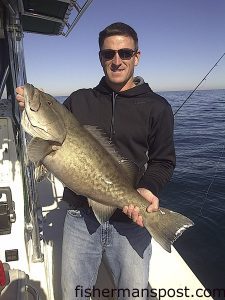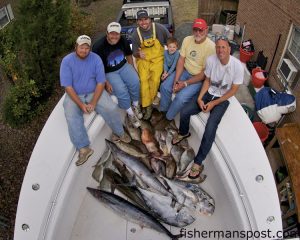Wrightsville Beach December 15, 2011

Paul Federico with a 33" gag grouper that struck a live Boston mackerel while he was bottom fishing some structure 10 miles off Wrightsville Beach with Capt. Chip Baker of Offshore Experiences Sportfishing.
Tex, of Tex’s Tackle, reports that anglers are hooking big numbers of speckled trout in the surf and inshore around docks, creeks, and channels at Wrightsville Beach. Most of the fish inside have been on the small side, with the surf fish nearly all keepers. MirrOlures, Gulp baits, and other soft plastics are top choices for the trout inshore or along the beachfront.
Depending on the weather, the trout action could stay good well into the new year, and anglers can count on the bite to stay good through at least Christmas barring any extreme cold weather. Generally, the cooler water means anglers will see larger trout as well.
A few flounder (including a 9 lb. fish weighed in last week) have been feeding alongside the specks and falling for soft plastics.
Surf casters are still putting together decent catches of sea mullet off the beach at Wrightsville while baiting up with shrimp.
King mackerel are feeding in the 30 mile range right now, and they’ll be present all winter wherever anglers can find a temperature break leading to mid-upper 60’s water. Trolling cigar minnows, sea witch/strip bait combos, or Drone spoons will tempt bites from the winter kings.
Bottom fishermen are reporting the best grouper action 30+ miles out. Anglers are catching some gags at structure closer to the beach, but black sea bass are so numerous that it’s tough to get a bait to them. The sea bass thin out a bit in the deeper water, and anglers also have shots at red and scamp groupers in addition to the gags when fishing further off the beach.
Boats making the run to the Gulf Stream are connecting with wahoo (many 50-60 lbs.) and good numbers of blackfin tuna. Rigged ballyhoo and a variety of trolling lures are fooling the wahoo and blackfins.
Jon, of Intracoastal Angler, reports that the speckled trout bite has been up-and-down lately, with some days producing solid action with keeper fish, and other days only witness to smaller fish and slower fishing. Live shrimp are top choices for the specks, but anglers can also hook them on MirrOlures, D.O.A. and Billy Bay shrimp, and a variety of soft plastic baits.
The area’s red drum are entering a winter pattern, and anglers should be able to locate them feeding in shallow water in the bays and creeks inshore. Searching for the fish by poling or with a trolling motor is the way to find them, and anglers can cast soft baits like Gulps to temp the cool water reds to bite.

Capt. Rick Croson, of Living Waters Guide Service, Brandon, Harold, and Chase Carter, Rick Croson, Sr., and Tony Del with wahoo, cobia, African pompano, groupers, triggerfish, and more that they hooked while deep jigging and trolling along the break off Wrightsville Beach.
Many of the larger reds inshore will be moving to the surf zone for the winter. The inlet shoals and beachfront sloughs are the places to look for the reds in the ocean, and Gulps, soft plastics, and a variety of other artificial lures will tempt the surf fish to bite.
The speckled trout and red drum action has also been good in the lower Cape Fear River, where the fish will also be active all winter long. The same baits will tempt bites from the fish in the river, and anglers may also be able to tempt them to bite topwater plugs on warmer days.
Offshore, gag grouper are still feeding at bottom structure within 15 miles of the beaches, and anglers have two weeks left to catch a few before their season closes down. Huge numbers of black sea bass (already closed to harvest) are in the same areas and often make it difficult to get a bait to the grouper, but going to larger baits will help anglers’ chances of hooking a gag.
Some king mackerel have been caught lately in the 30 mile range, and they’ll be feeding in the vicinity of temperature breaks in the 40+ mile range all winter long.
The wahoo bite is still solid when boats can make it out to the Gulf Stream. Most of the ‘hoos are falling for ballyhoo under skirted trolling lures (particularly in black color combos).
Rick, of Living Waters Guide Service, reports that wahoo and blackfin tuna are feeding in the Gulf Stream and should be there for most of the winter. Trolling ballyhoo or high-speed lures or vertically jigging will produce action with both.
Cobia, African pompano, amberjacks, and a host of groupers and other bottom dwellers are feeding at structure along the break, and the fishing will only get better as winter progresses. Dropping vertical jigs to areas in 140-280’ of water will tempt bites from those species and many more.
Jim, of Plan 9 Charters, reports that striped bass are feeding in the Cape Fear River. Casting soft plastic baits, hard lures like Rat-L-Traps, and (on warmer days) topwater plugs will tempt bites from the stripers. Channel drop-offs and shoreline structure are the best places to look for the fish.
Bottom fishing 10-15 miles offshore has been producing good numbers of gag grouper, but big numbers of black sea bass are often beating the groupers to the baits. Larger and live baits will help anglers target the gags.
Steve, of Johnnie Mercer’s Pier, reports that anglers are picking up a lot of speckled trout from the pier (with a mix of undersized and keeper fish). Soft plastic baits on jigheads have been doing most of the damage on the specks.

Vaughan L. Pusey, Jr., of Wilmington, with an upper-slot red drum that bit a MirrOlure in Masonboro Inlet.
Bottom fishermen are hooking pufferfish, sea mullet, and some bluefish. Shrimp and cut baits are producing results on the bottom rigs.
The water is 59.7 degrees, and it shouldn’t be long until spiny and smooth dogfish are feeding around the pier, just in time for the Dogfish Tournament on January 28.





